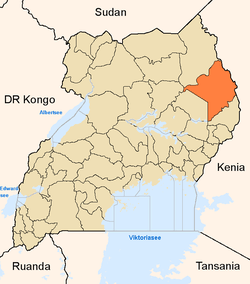Moroto District
| Moroto District | |
|---|---|
| District | |
 District location in Uganda | |
| Coordinates: 02°32′N 34°40′E / 2.533°N 34.667°ECoordinates: 02°32′N 34°40′E / 2.533°N 34.667°E | |
| Country |
|
| Region | Northern Region of Uganda |
| Sub-region | Karamoja sub-region |
| Capital | Moroto |
| Area | |
| • Total | 3,537.6 km2 (1,365.9 sq mi) |
| Population (2012 Estimate) | |
| • Total | 136,000 |
| • Density | 38.4/km2 (99/sq mi) |
| Time zone | EAT (UTC+3) |
| Website |
www |
Moroto District is a district in the Northern Region of Uganda. The town of Moroto is the site of the district headquarters.
Location
Moroto District is bordered by Kaabong District to the north, Kenya to the east, Amudat District to the south, Nakapiripirit District to the southwest, Napak District to the west, and Kotido District to the northwest. Moroto District is at the foot of Mt. Moroto. The town of Moroto is approximately 210 kilometres (130 mi), by road, northeast of Mbale, the nearest large city.[1] The coordinates of the district are 02 32N, 34 40E.
Overview
Moroto District is part of the larger Karamoja sub-region. The population of the sub-region was estimated at 800,000 by the 2002 national census.
Moroto District is a plain covered by savannah grassland and some low-lying rocky hills. It is composed of three counties: Bokora County, Matheniko County, and Moroto Municipality. It is inhabited by the Karimojong, a distinctive ethnic group that highly cherishes its traditions.
The district is a hub of mineral resources that are yet to be optimally exploited. There are over fifty different minerals and precious stones in the Karamoja region. Of these, Moroto has gold, silver, copper, iron, titanium, manganese, niobium, tantalite, and chrome. Other proven minerals include marble, mica, garnets, limestone, and asbestos.[2][3]
Population
In 1991, the national census estimated the district population at 59,100. The 2002 national census estimated the population at 77,200. Between 2002 and 2012, it is estimated that the district population grew 5.9 percent annually. In 2012, it was estimated that the population had grown to 136,000.[4]
References
- ↑ "Road Distance Between Mbale And Moroto With Map". Globefeed.com. Retrieved 23 May 2014.
- ↑ Mwesigwa, Alon (4 February 2014). "Mineral Deposits In Uganda's Karamoja Heighten Human Rights Abuse – Report". The Guardian. Retrieved 23 May 2014.
- ↑ Ariong, Steven (5 April 2014). "Karamoja Miners Demand Mineral Weighbridges". Retrieved 23 May 2014.
- ↑ "Estimated Population of Moroto District In 1991, 2002 & 2012". Citypopulation.de. Retrieved 23 May 2014.